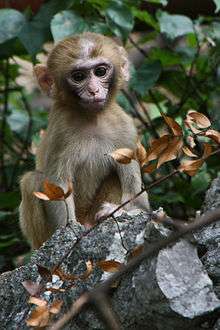Gecker

A gecker is a vocalization most often associated with baby primates. Common in rhesus macaques,[1] geckering is also associated with fearful jackals and mongooses.[2] Patas monkeys have also been observed to gecker.[3] In 1965, Irven DeVore of the Center for Advanced Study in the Behavioral Sciences described geckering as a "single sharp yak sound", which may be repeated.[4] It has also been characterized as "cackling."[2] In macaques, geckering is associated with spastic jerking of the body.[5] Among macaques, the behavior was found to be most common in infants of two to four months (35%) with younger infants following (26%), but was recorded in macaques up to 41 months old.[1]
The vocalization is frequently reported as a distress cry.[1] A 1974 study questioned this conclusion; it found that geckering seemed to be a spontaneous occurrence among infant macaques in many different situations and that older infants, who geckered far less frequently, exhibited different behaviors in situations where they were plainly fearful.[5] A four-year study of geckering reported in 2004 found that the vocalizations most often occurred either for no obvious reason when the infant was with its mother (31.1%) or as the mother was physically moving away from the infant (13.5%). In 49% of cases, the mother paid attention to or renewed contact with the geckering infant, which led the studiers to suggest that the purpose of geckering was to call for maternal attention.[1]
References
- 1 2 3 4 Patel, E.R. and M.J. Owren "Acoustic and Behavioral Analyses of 'Gecker' Distress Vocalizations in Young Rhesus Macaques (Macaca Mulata) (Abstract)" American Journal of Primatology Vol 62, Issue Supplement 1. 11 May 2004. p. 48.
- 1 2 Estes, Richard Despard (1991) The Behavior Guide to African Mammals: Including Hoofed Mammals, Carnivores, Primates University of California Press. ISBN 978-0-520-08085-0 p. 561.
- ↑ Jacobus, Sharon and Jamie Loy The Grimace and Gecker: A Submissive Display among Patas Monkeys" Primates 22(3). July 1981. p. 393.
- ↑ DeVore, Irven; Center for Advanced Study in the Behavioral Sciences (Stanford, Calif.) (1965). Primate Behavior: Field Studies of Monkeys and Apes. Holt, Rinehart and Winston. p. 90.
- 1 2 Suomi, Stephen J. and Harry F. Harlow; University of Wisconsin. "The Facts and Functions of Fear" in Emotions and Anxiety: New Concepts, Methods, and Applications, ed. Marvin Zuckerman and Charles D. Spielberger (Hillsdale, NJ: Lawrence Erlbaum Associates, 1976), p. 15, http://www.questia.com/read/26173386. Citing J.B. Sidowski "Convulsions in Infant Monkeys" Bulletin of the Psychonomic Society, 1974, 4, 307.